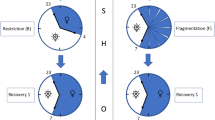Abstract
Behavioral control of abnormal breathing in sleep was studied to determine if an intervention procedure could reduce apnea duration and also SaO 2 (blood oxygen) desaturation levels. Sleep apnea patients (n=11) were instructed while awake that tones would be presented in sleep whenever an apnea event occurred. They were told to breathe deeply to the tones and were given practice in doing so. Intervention and nonintervention hours alternated across 2 nights following 2 baseline nights. As expected, during the intervention hours, the duration but not the frequency of apneic events was reduced. The procedure also resulted in higher SaO 2 levels during the intervention hours. Daytime sleepiness was not greater following intervention but sleep staging effects were observed. The results are sufficiently promising to warrant additional research.
Similar content being viewed by others
References
Badia, P., Harsh, J., Balkin, T., O'Rourke, D., and Burton, S. (1985). Behavioral control of respiration in sleep and sleepiness due to signal-induced sleep fragmentation.Psychophysiology 22: 517–524.
Badia, P., Harsh, J., and Balkin, T. (1986). Behavioral control over sleeping respiration in normals for ten consecutive nights.Psychophysiology 23: 409–411.
Caskadon, M. A., Dement, W. C., Mitler, M. M., Roth, T., Westbrook, P. R., and Keenan, S. (1986). Guidelines for the multiple sleep latency test (MSLT): A standard measure of sleepiness.Sleep 9: 519–524.
Guilleminault, C. (1985). Obstructive sleep apnea: The clinical syndrome and historical perspective. In Thawley, S. e. (ed.),Sleep Apnea Disorders: Medical Clinics of North America, Vol. 69 (6), pp. 1187–1204.
Harsh, J., Purvis, B., Badia, P., and Magee, J. (1988). Behavioral responsivity during the sleep of older adults.Psychophysiology (in press).
Roehrs, T., Zorick, F., Sicklesteel, J., Wittig, R., and Roth, T. (1983). Excessive daytime sleepiness associated with insufficient sleep.Sleep 6(4): 319–325.
Smallwood, R., Vitiello, M. V., Giblin, E. C., and Prinz, P. N. (1983). Sleep apnea: Relationship to age, sex, and Alzheimer's dementia.Sleep 6(1): 16–22.
Author information
Authors and Affiliations
Additional information
This research was supported by NIH Grants 2 HL 27149-84 and HL 34125 entitled “Behavioral Control of Respiration in Sleep”.




